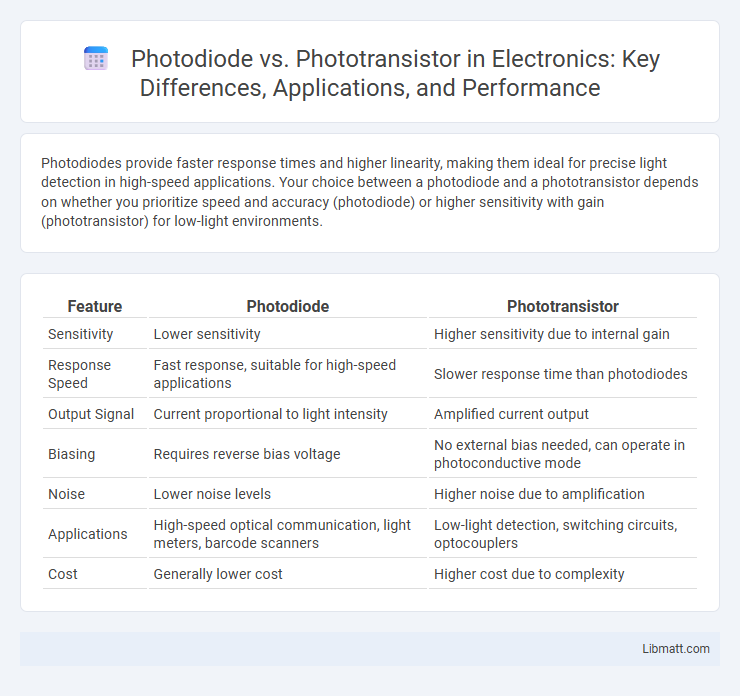Photodiodes provide faster response times and higher linearity, making them ideal for precise light detection in high-speed applications. Your choice between a photodiode and a phototransistor depends on whether you prioritize speed and accuracy (photodiode) or higher sensitivity with gain (phototransistor) for low-light environments.
Table of Comparison
| Feature | Photodiode | Phototransistor |
|---|---|---|
| Sensitivity | Lower sensitivity | Higher sensitivity due to internal gain |
| Response Speed | Fast response, suitable for high-speed applications | Slower response time than photodiodes |
| Output Signal | Current proportional to light intensity | Amplified current output |
| Biasing | Requires reverse bias voltage | No external bias needed, can operate in photoconductive mode |
| Noise | Lower noise levels | Higher noise due to amplification |
| Applications | High-speed optical communication, light meters, barcode scanners | Low-light detection, switching circuits, optocouplers |
| Cost | Generally lower cost | Higher cost due to complexity |
Introduction to Photodiodes and Phototransistors
Photodiodes are semiconductor devices that convert light into electrical current through the photoelectric effect, offering fast response times and high sensitivity for low-light detection. Phototransistors combine the properties of photodiodes with transistor amplification, enabling greater current output and enhanced sensitivity but with slower response speeds. Both components are essential in optical sensing applications, with photodiodes preferred for precision and speed, while phototransistors excel in applications requiring higher signal amplification.
Working Principle: Photodiode vs Phototransistor
Photodiodes operate by converting light into current through the photoelectric effect, where incoming photons generate electron-hole pairs, resulting in a proportional photocurrent. Phototransistors amplify this photocurrent using transistor action, allowing for higher sensitivity as the initial photogenerated charge controls the base current of the transistor. While photodiodes provide fast response times with linear output, phototransistors offer greater current amplification but generally slower response due to transistor gain mechanisms.
Types and Variants Available
Photodiodes come in types such as PIN, avalanche, and Schottky, each offering specific advantages in speed, sensitivity, and wavelength range. Phototransistors are available in bipolar and MOS varieties, with configurations like NPN and PNP structures tailored for different amplification gains and switching speeds. Both devices include specialized variants like infrared, visible light, and ultraviolet-sensitive models for targeted optical detection applications.
Key Performance Parameters Compared
Photodiodes exhibit faster response times and higher linearity, making them ideal for high-speed optical detection, while phototransistors offer greater sensitivity and signal amplification due to their internal gain. Your choice depends on the required spectral response, noise level, and bandwidth; photodiodes excel in low-noise applications, whereas phototransistors provide stronger output signals in low-light conditions. Key performance parameters such as quantum efficiency, dark current, rise time, and spectral range vary between these components, influencing their suitability for specific sensing tasks.
Sensitivity and Responsivity Differences
Phototransistors exhibit higher sensitivity compared to photodiodes due to internal gain mechanisms that amplify the photocurrent, making them suitable for low-light detection. Photodiodes offer faster response times and more linear responsivity across a broad wavelength range, ideal for high-speed applications. Responsivity of photodiodes typically ranges from 0.4 to 0.7 A/W, while phototransistors can achieve higher effective responsivity but with slower response and increased noise.
Speed and Response Time Analysis
Photodiodes possess faster response times, typically in the nanosecond range, due to their simple p-n junction structure, making them ideal for high-speed applications. Phototransistors exhibit slower response times, often in the microsecond range, as their internal amplification involves charge carrier recombination processes. Your choice between photodiodes and phototransistors should prioritize speed requirements, with photodiodes preferred for rapid signal detection.
Typical Applications and Use Cases
Photodiodes are commonly used in high-speed optical communication systems, light measurement devices, and laser range finders due to their fast response time and linearity. Phototransistors find applications in low-light detection, such as in night lights, optical switches, and proximity sensors, where higher sensitivity is essential. Your choice between the two should consider the specific speed and sensitivity requirements of your optical sensing application.
Circuit Integration and Design Considerations
Photodiodes offer faster response times and linearity, making them ideal for high-speed circuit integration with minimal design complexity. Phototransistors provide higher sensitivity and gain, requiring careful biasing and compensation for slower response and increased noise in your design. Selecting between the two depends on your circuit's speed requirements, sensitivity needs, and overall integration constraints.
Advantages and Limitations of Each Sensor
Photodiodes offer faster response times and higher linearity, making them ideal for precise, high-speed light detection applications, but they typically produce lower output current requiring amplification. Phototransistors provide higher sensitivity and stronger signal output without additional amplification, suitable for low-light environments, though they have slower response times and increased susceptibility to noise. The choice between photodiodes and phototransistors depends on the specific requirements of speed, sensitivity, and signal strength in optical sensing tasks.
Choosing the Right Device for Your Application
Photodiodes offer faster response times and higher precision for low-light detection, making them ideal for high-speed and accurate light measurement applications. Phototransistors provide greater sensitivity and amplification, suitable for applications requiring more significant signal strength without external amplification. Your choice depends on the required speed, sensitivity, and circuit complexity of your specific application.
Photodiode vs Phototransistor Infographic

 libmatt.com
libmatt.com